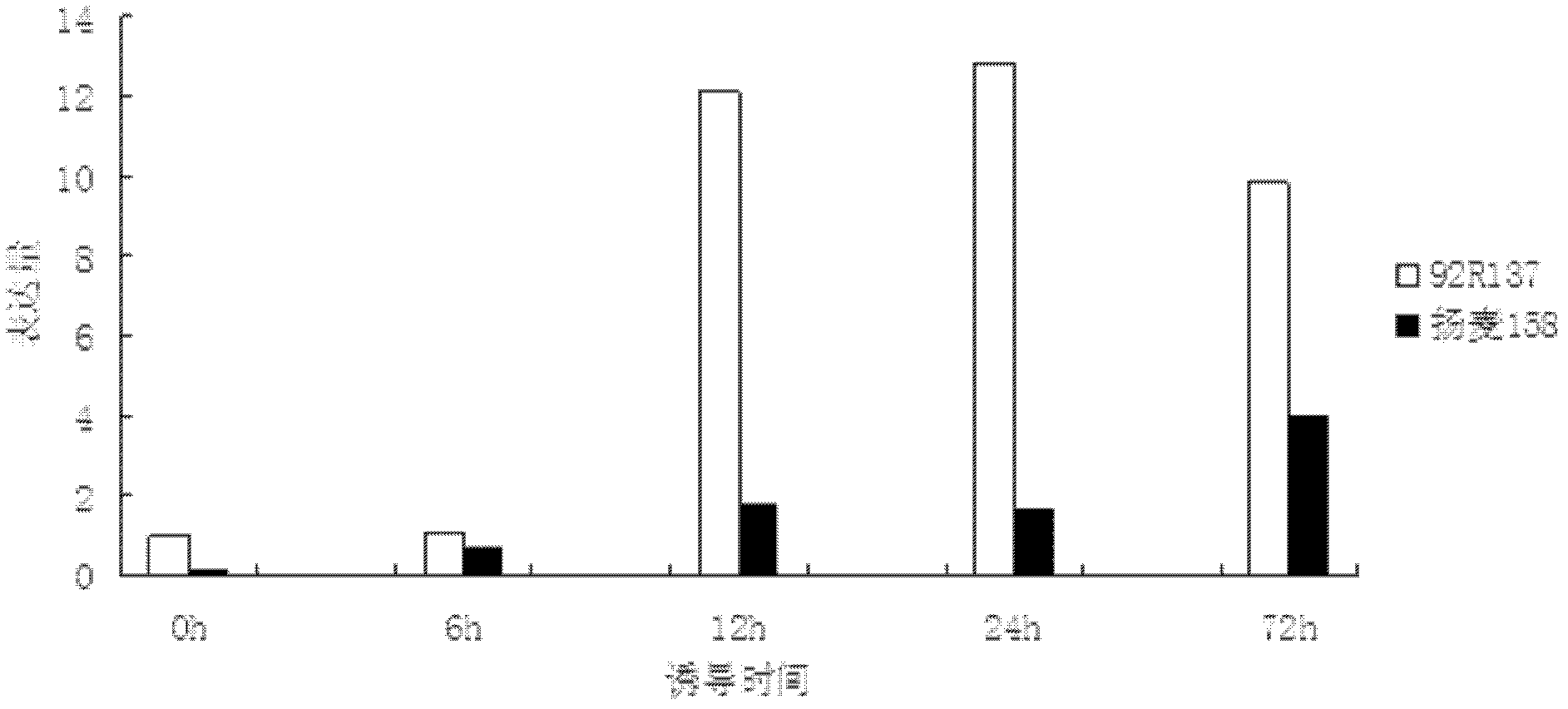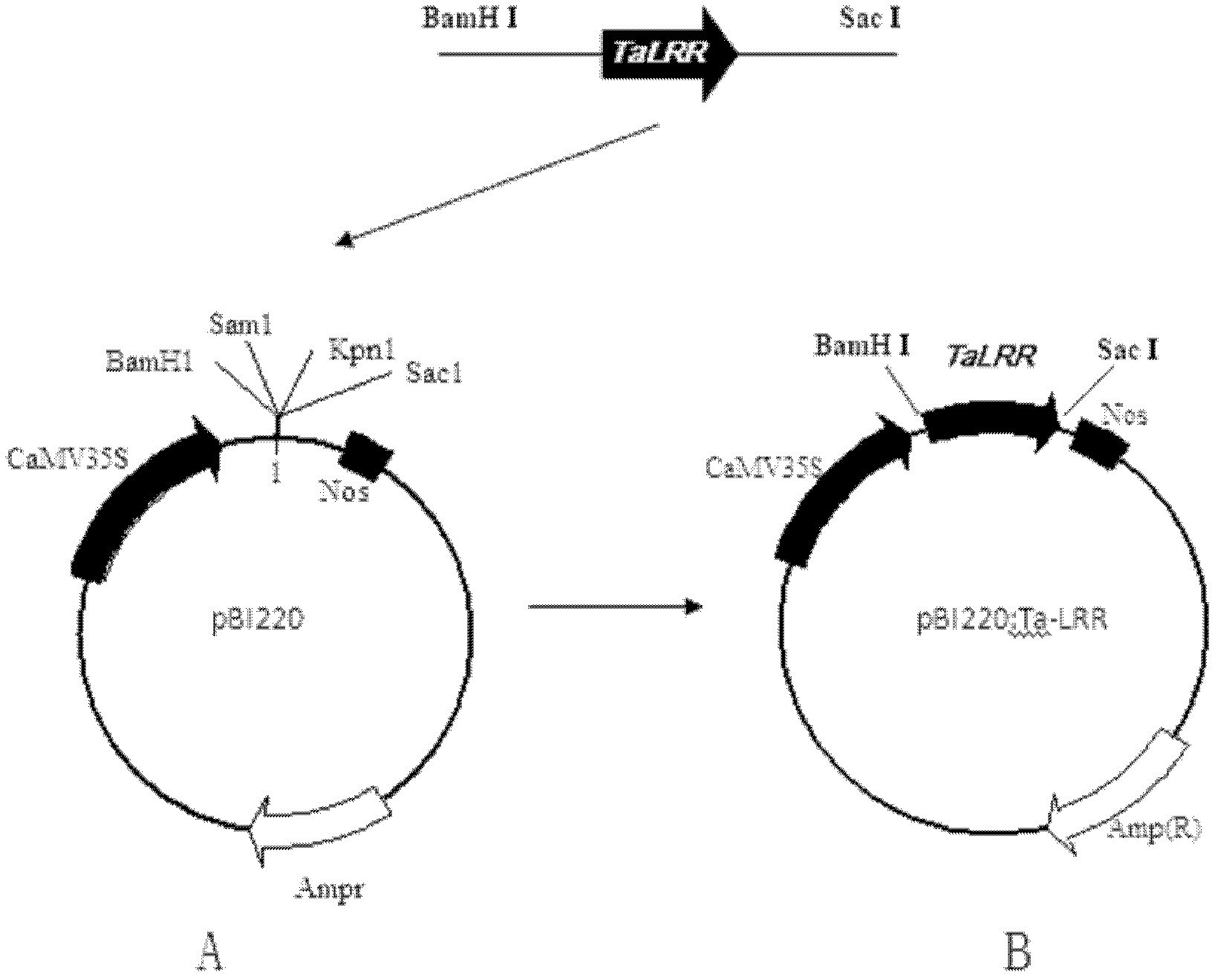Transmembrane protein gene triticum asetivum leucine rich repeat 3 (TaLRR3) with leucine rich repeat (LRR) structure domain as well as expression vector and application thereof
A technology of transmembrane protein and expression vector, applied in the field of genetic engineering, can solve the problems of lack of new resistance source, outbreak of stripe rust, economic loss and so on
- Summary
- Abstract
- Description
- Claims
- Application Information
AI Technical Summary
Problems solved by technology
Method used
Image
Examples
Embodiment 1
[0025] Example 1 Cloning of the transmembrane protein gene Ta-LRR with LRR domain induced by stripe rust in 92R137
[0026] 92R137 is a translocation line created by Nanjing Agricultural University by crossing tetraploid Triticum turgitum with diploid Triticum villosa (Haynaldia villosa) and backcrossing with hexaploid common wheat several times. (Chen, P.D., Qi, L.L., Zhou, B., S.Z. Zhang, D.J. Liu. 1995 Development and molecular cytogenetic analysis of wheat-Haynaldia villosa 6VS / 6AL translocation lines specifying resistance to powdery mildew. TAG, (91): 1125-1128 .). Chromosome 1B of 92R137 contains the wheat stripe rust resistance gene Yr26, which has a high level of resistance to dominant races such as 29, 31, and 32 in the highly virulent race (Chunmei Wang, Yiping Zhang, Dejun Han, Zhensheng Kang, Guiping Li, Aizhong Cao, Peidu Chen. SSR and STS markers for wheat stripe rust resistance gene Yr26. Euphytica, 2008, 159: 359-366.).
[0027] In order to clone the resistan...
Embodiment 2
[0029] The expression characteristics of embodiment 2 TaLRR3 gene being induced by stripe rust
[0030] In order to study the expression pattern of TaLRR3 in stripe rust resistant materials, the RNA reverse transcription cDNA of the resistant material 92R137 and the susceptible material Yangmai 158 induced by stripe rust for 0, 6, 12, 24, and 72 hours were used as templates. Real-time fluorescence quantitative PCR (Q-PCR) analysis was performed using P1 and P2 as primers. The PCR program is as follows: the PCR reaction is amplified on a real-time fluorescent quantitative PCR instrument (MyIQ, Bio-Rad Company, USA) and the fluorescence is detected. The 20uL PCR reaction system contains 10uL of 2×SYBR Green PCR Master Mix, 0.5μM primers P1 and P2, 2uL of reverse transcription cDNA template, and supplemented with water to 20uL. The amplification parameters were: 95°C for 10 minutes, then 95°C for 15 seconds, 60°C for 30 seconds, and 72°C for 1 minute, a total of 40 cycles. Afte...
Embodiment 3
[0031] Example 3 Construction of TaLRR3 overexpression vector and its transformation into common wheat Yangmai 158 and identification of resistance to stripe rust
[0032] Using the cDNA from 92R137 as a template, primers P3 (CGCGGATCCATGGCTGATGATACCAAG, SEQ ID NO.5) and P4 (CGAGCTCTCATATCCGGACGACGTA, SEQ ID NO.6) across the ORF were designed with the full-length sequence of the TaLRR3 gene obtained by the RACE method, and P3 With BamHI restriction site, P4 with SacI restriction site. PCR amplification was performed using primer pairs P3 and P4, and amplified fragments were recovered. The amplified product was double digested with BamHI and SacI, and the digested product was inserted into the vector pBI220 (Jefferson RA, Kavanagh TA, Bevan MW. GUS fusions: beta-glucuronidase as a sensitive and versatile gene fusion marker in higher plants. EMBO J.1987, 6:3901-3907.), put TaLRR3 at the multiple cloning site behind the 35S promoter, and replace the GUS gene carried by the vecto...
PUM
 Login to View More
Login to View More Abstract
Description
Claims
Application Information
 Login to View More
Login to View More - R&D
- Intellectual Property
- Life Sciences
- Materials
- Tech Scout
- Unparalleled Data Quality
- Higher Quality Content
- 60% Fewer Hallucinations
Browse by: Latest US Patents, China's latest patents, Technical Efficacy Thesaurus, Application Domain, Technology Topic, Popular Technical Reports.
© 2025 PatSnap. All rights reserved.Legal|Privacy policy|Modern Slavery Act Transparency Statement|Sitemap|About US| Contact US: help@patsnap.com



